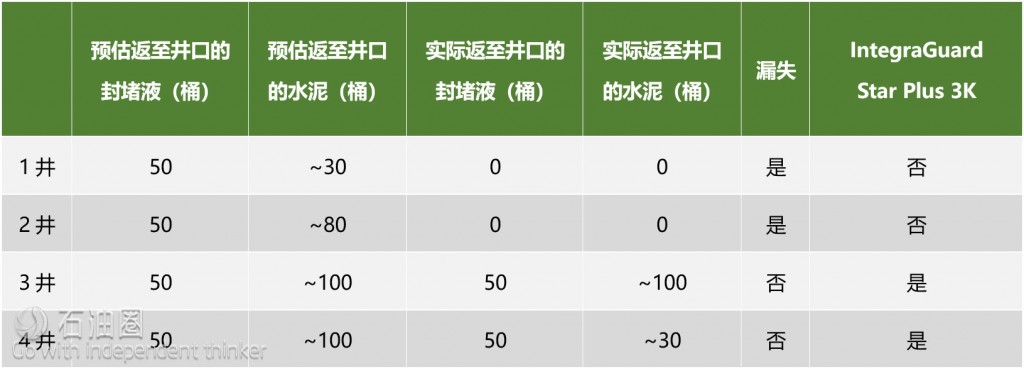Evolving well construction practices in North America have focused on finding ways to decrease well costs. One general well design theme has been to minimize the number of casing strings to reduce material cost and time per well. However, in minimizing the number of sections, longer cemented sections are required which often creates a risk of lost circulation during cementing. To help mitigate this risk, lowering cement slurry density can reduce the hydrostatic pressures while placing cement — but systems to minimize lost circulation volumes in thief zones are also an important tool.
IntegraGuard Star cement spacer system is a unique, well-proven solution for eliminating cement losses associated with cementing operations.
Cement losses, either during cementing or as fallback after cement placement, can cause expensive remedial work. Curing losses ensures planned cement tops and can save excess cement slurry costs and even eliminate the need for intermediate casing strings.
IntegraGuard Star uses advanced fluid and particulate technologies that create a barrier at the formation face, effectively strengthening the wellbore, minimizing fluid invasion and sealing fluid loss paths.
In extreme situations, additional sealant, IntegraGuard Star Plus, can be added to enhance the system sealing capability.
The lost circulation capability is provided without compromising the primary function of a spacer, effective mud removal and cement placement. The IntegraGuard Star spacer system provides temperature stability, fluid compatibility and the capability to design specific density and viscosity expected from a premium cement spacer. This system can also be used in stand-alone lost circulation situations.
BJ Services’ IntegraGuard™ Star spacer systems have a long history of successfully reducing lost circulation. In laboratory experiments, the system can completely block fluid flow through high-permeability media, impressively stopping fluid losses into pea-size gravel.
But because many lost circulation scenarios involve fluid losses into fractures, we launched a new R&D initiative to evaluate the current IntegraGuard Star system capabilities and develop product enhancements.
The main test apparatus used was a slot tester. This is a pressurized fluid cell with interchangeable-width slot fixture. The slot has a parallel-sided, 1-in long opening, with widths up to 4 mm. Current IntegraGuard Star spacer systems could successfully seal a 1-mm slot with a differential pressure of 1,000 psi.
The challenge for the new system was to seal a 3-mm slot with differential pressures up to 3,000 psi. After extensive development and testing, a new system that incorporates a lost circulation material (LCM) was developed and branded IntegraGuard Star Plus 3K. This technology has produced breakthrough results in both the laboratory and the field, surpassing the capabilities of current spacers on the market. During laboratory testing, it exceeded expectations when it remarkably sealed a 3-mm slot up to 4,000 psi and a 4-mm slot up to 3,000 psi.
Field trials then began for IntegraGuard Star Plus 3K in March 2019, and the system has rapidly gained traction due to excellent results — 13 jobs in April and 25 jobs in May. In most field trials, the IntegraGuard Star Plus 3K system was able to establish cement returns to surface, which ensures regulatory compliance, zonal isolation and wellbore integrity. Additionally, one operator used the additive in a cement job redesign that eliminated the two-stage cementing in favor of a successful one-stage design—resulting in lower well costs and reduced well construction time.
IntegraGuard™ Star Plus 3K Combats Severe Lost Circulation Issues in the Rockies
On a two-well pad development in the Williston Basin, fluid returns and a post-job pressure-matching analysis indicated an operator was experiencing severe lost circulation while cementing a 7-in. intermediate casing set at 11,000 ft. A detailed pressure analysis showed that the lost circulation zones were potentially in the Mission Canyon Formation at ~10,000 ft, with estimated losses between 40 to 60%.
In this area, state requirements mandate that the Dakota formation must be isolated with cement at ~5,000 ft to fracture stimulate the wells down the casing. Without adequate isolation, a smaller diameter frac string would have to be used, resulting in pump rate limitations during stimulation, increased treatment pressures and horsepower pump charges, and a higher risk of compromising the fracture stimulation efficiency and well production potential.
BJ Services was consulted to help mitigate these losses to ensure cement coverage across the Dakota formation. An IntegraGuard Star spacer system using the IntegraGuard Star Plus 3K lost circulation technology was recommended. This advanced fluid was specifically developed for lost circulation scenarios that involve fluid losses into fractures. Additionally, the job design was slightly modified by reducing the pump rates to lower the cementing equivalent circulating densities (ECD) without compromising mud displacement efficiencies.
On the third and fourth wells, 50 bbls of IntegraGuard Star spacer with IntegraGuard Star Plus 3K was pumped ahead of the cement. This resulted in spacer and lead cement returns to surface on both wells and no lost circulation indicated from a pressure-matching analysis. Figure 1 shows the pre-job gauge-hole cement fluid return estimates and compares it to the actual fluid returns observed. A bond log analysis is planned to confirm initial findings. Due to this sytem’s performance, the operator continues to use it on similar pad wells.

 石油圈
石油圈

